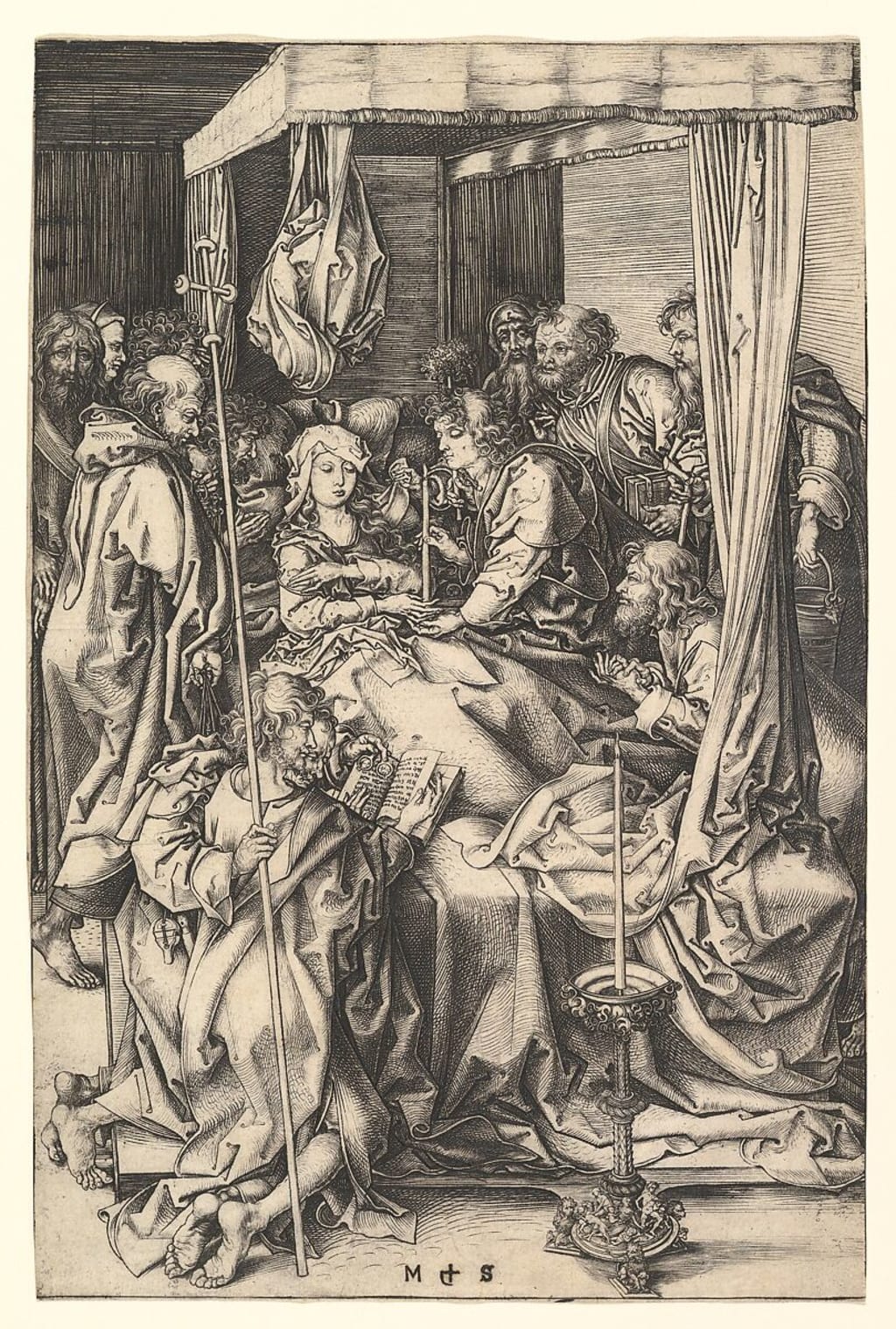
Martin Schongauer is often quoted as being the “master” of printmaking, second only to Albrecht Durer. Some of the other nicknames he acquired in his lifetime were “Pictorium Gloria” and “Martin Hubsch” both of which are seen as a great honor and a title given to very few of his time. Through his many years of printmaking, he’s inspired many artists who went on to become well known in their own regard and practice. He had his works displayed in thousands of homes across Europe, his work even impressing the renowned Michelangelo with his etching of “Temptations of St. Anthony.”
Though his place of birth and death are unknown, it is theorized that he was born in Colmar sometime during the year of 1448. He passed away on February 2nd in 1491 at the age of 43 and at the “pinnacle” of his success. Schongauer is a strange and mysterious man for someone so prolific in the history of print, as not much is known of his early life- even his days as an apprentice are unknown to historians. Schongauer was a German artist during the Beginning of the Renaissance. The Renaissance is known for being a time period where European history shifted from the Middle Ages to a time of modernity, technological advancement and artistic celebration. This can be seen in most of Schrongauer’s prints and engravings, including his print titled “The Death of the Virgin” from his early years as a print maker.
During this time of technological advancement came the invention of the printing press. Additionally, printmaking was beginning to be seen more and more as an art form rather than a discipline. Because the Renaissance was during a time of prosperity after the Black Plague, common people had more disposable income to spend on items such as books or single prints. This new source of patronage and income for artists is just one of the many ways that Schongauer became as widely known as he is today. Perhaps this was one of the reasons he was the first to consistently sign his works. In his early works he actually would use a pre-made stamp, which made the ‘S’ in his monogram seem expertly crafted. Later on he decided to etch the monogram into the actual piece he was working on, but at this time he had gained ample skills and was able to execute the ‘S’ fairly well every time.
Looking at “The Death of the Virgin '' it has many varying lines - some thick, others thin - there is even an impression of hatching. But even with its busy scenery full of varying lines, the environment of the work is controlled. Despite the scene of this work taking place indoors, it is mostly consistent with organic shapes; with only the bedframe and a few smaller objects making up geometric shapes in the work.
The etching patterns used in this work suggest 3-dimensionality, which is most easily noticeable in the bundled up cloth hanging from Mary’s bed on the left, just above the men who are holding a bible. The way the space is arranged in the work has lots of figures in the bottom half, and the rule of thirds puts Mary in a position that successfully shows she is the true subject of this work. She sits unworried, among the Apostles who all seem to be holding their breath as they wait for what happens next. The inclusion of the apostles is central to the story of the Death and Annunciation of Mary, who requested that the angel who would grant her reunion with her son that they be there for her final moments.
The work has little negative space and is closely cropped in a vertical composition. Here, it is difficult to say whether the time is implied or the actual passage of time is shown. It seems to represent those quiet moments before someone passes, when all you can really do is sit there and wait, what needs to be said has been said and all that’s left is the inevitable. Though the work shows a sense of stillness there is an actual passage in time that can be implied simply from the amount of detail that went into it. Though this is believed to be one of Schongauer’s earlier works, it has been analyzed as being on par with the decorative and detailed quality as some of his later works- specifically showing similarities in hatching styles when compared to ‘Christ as Teacher’.
There are other areas in the work that have implied movement- such as the way the men are positioned, some leaning forward, another just about to turn the page of a book. Though there is no color in this work except for the black ink used, there is a large value variation created with the marks left and those scraped away by Schongauer, with a much lighter foreground and a darkened background. Though there are multiple smaller scenes happening within the work, they all compliment each other to create a unified composition. The three miniature scenes in this work are reminiscent of religious Triptychs, which would of still been a popular form of commission for artists at this time.
In order to truly understand the masterpiece that is Schongauer’s work, you have to use a magnifying glass. From Mary’s delicate pale face to the bunched up drapery to the large candlestick near Schongauer’s monogram. Immense detail and linework can be found over every inch of this print. “Extremely fine parallel lines are used to model faces and hands, and to distinguish, almost obsessively, the various textures or skin, hair and textiles.” You can see just the amount of work put into this the closer you get to the work; noticing the details put into the feet of the men on the far left or the bags under the eyes of the older Apostle. This work is 10 1/8 x 6 11/16 inches, so even though this is larger than today’s standard book size, that still means he had to get a lot of details into a small area. This detailed precision is one of the ways he shows an artistic celebration in the form of Printmaking. His many use of textures through line variation show a great deal of experimentation and attention to detail, in some places appearing more as a drawing rather than an etched print.
Schongauer was a figure that others in the field frequently looked up to; even Durer wished to be his student. His work was often copied as practice for other engravers (imitatio). There is even a great deal of his influence seen in Aragon specifically through a publisher known as Hurus. The publisher put a woodcut modeled after Martin’s “Death of the Virgin” in a publication of Breydenbach’s tales of Jerusalem’s sacred sites. This was 50 years after Schonaguer’s death, but it just goes to show the reach his art had, as Hurus would continue to copy not only “Death of the Virgin '' but many of his other engravings throughout the following years. Hurus’s use of “Death of the Virgin'' in Breydenbach’s story served two functions- “exemplary pictorial model and a testament to the artistic merit of an internationally renowned artist.” Hurus also used this work and many others specifically as devotional images in his publications enhancing the text they accompany.
But it was not just Hurus who appropriated his works. Even the well renowned Durer is proven to have appropriated one of Schongauer’s prints- which so happened to be that of “The Death of the Virgin.” Though there are many uncanny similarities between Durer’s and Schonaguer’s “Death of the Virgin” Durer made some compositional changes that alters the piece enough to be considered an original rather than a copy or emulation. The most noticeable similarity are the accompaniment of the 12 apostles surrounding Mary and the tied up drapery near the end of the bed. But aside from that, they do approach the subject differently. Schongauer’s was cropped tightly and most of the space is filled with bodies,. Where Durer’s takes a step back and leaves lots of open geometric space towards the top of the work. Another individual that appropriated his work was Michelangelo, who recreated Schongauer’s “Temptations of St. Anthony”.
Schonaguer’s prints exemplify the Renaissance period, with his prints reaching new heights of painterly quality and detail. Through the use of hatching with varying spaces, he “introduced a novel form of artistic expression.” This is especially noticeable in one of his earlier prints “The Death of the Virgin.” Schonguer’s prints inspired many other artists who would become well known in their time as some of the ‘greats’ including Durer and Michelangelo. Even 50 years after Schongauer’s death, his prints were still being used; especially in Aragon where his prints were accompanied by devotional texts, giving those texts additional and sometimes subversive meanings.
Works Cited
Alarcon, Carolina “Fashioning Schongauer: The Appropriation of Martin Schongauer’s Engravings in Aragon” pp. 1-47 (2011): Fsu:253817
Anzelewsky, Fedja “Martin Schongauer’s Presentation in the Temple” Master Drawings Vol. 37 No. 3 pp. 262-270 (1999): https://www.jstor.org/stable/1554380
Ferguson, George “Signs and Symbols in Christian Art” pp. 42-44 (1959)
Korney, Fritz “Martin Schongauer as a Draftsman: A Reassessment” Master Drawings Vol. 34 No. 2 pp. 123-147 (1996): https://www.jstor.org/stable/1554261
Korney, Fritz “Notes on Martin Schongauer” Print Quarterly Vol. 10 No. 4 pp. 385-391 (1993): https://www.jstor.org/stable/41825159
Stucke, Thomas Eitel “Martin Schongauer” Illustration History, (2018) https://www.illustrationhistory.org/artists/martin-schongauer
About the Creator
QuirkyMin
Aspiring writer, sharing articles of personal interest as well as original short stories.
https://linktr.ee/quirky.min






Comments (1)
I took a course on different forms of printmaking, and I wish we had discussed this craftsman. Thank you for this!